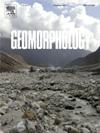New luminescence chronology of a loess-paleosol sequence at Jinchuan and its implications for aeolian deposition processes in the Tibetan Plateau
IF 3.1
2区 地球科学
Q2 GEOGRAPHY, PHYSICAL
引用次数: 0
Abstract
Aeolian loess deposits in the Tibetan Plateau (TP) are critical archives for documenting the plateau's aridification and past environmental changes. However, the lack of detailed chronological control over the TP loess sequences has hindered a more comprehensive understanding of aeolian processes, the TP's arid history, and its response to global climate change. This study investigates a well-preserved loess-paleosol sequence at Jinchuan in the eastern TP, employing single-aliquot regenerative-dose (SAR) optically stimulated luminescence (OSL) and post-infrared infrared stimulated luminescence (pIRIR) protocols to establish a robust chronology and elucidate the dust history and development of loess landscapes in the TP. Our results demonstrate that quartz SAR OSL dating provides reliable ages up to ~50 ka, while the pIR200IR290 protocol extends age control to ~160 ka for the Jinchuan loess sequence. The newly established numerical chronology for the Jinchuan loess, spanning the Last Interglacial, reveals significant glacial-interglacial fluctuations in dust activity, characterized by increased dust accumulation during glacial periods and decreased accumulation during interglacial periods on the TP. By integrating OSL ages, extrapolated dust accumulation rates, identified S1–S5 paleosols, and correlations between magnetic susceptibility curves and marine isotope stage records, we estimate the basal age of the MC loess-paleosol sequence to exceed approximately 620 ka. This suggests that an arid environment and extensive aeolian loess landscapes have developed on the TP since the mid-Pleistocene. Global climate change has served as the primary driver in shaping the geomorphic development and dust accumulation history of this region.
求助全文
约1分钟内获得全文
求助全文
来源期刊

Geomorphology
地学-地球科学综合
CiteScore
8.00
自引率
10.30%
发文量
309
审稿时长
3.4 months
期刊介绍:
Our journal''s scope includes geomorphic themes of: tectonics and regional structure; glacial processes and landforms; fluvial sequences, Quaternary environmental change and dating; fluvial processes and landforms; mass movement, slopes and periglacial processes; hillslopes and soil erosion; weathering, karst and soils; aeolian processes and landforms, coastal dunes and arid environments; coastal and marine processes, estuaries and lakes; modelling, theoretical and quantitative geomorphology; DEM, GIS and remote sensing methods and applications; hazards, applied and planetary geomorphology; and volcanics.
 求助内容:
求助内容: 应助结果提醒方式:
应助结果提醒方式:


